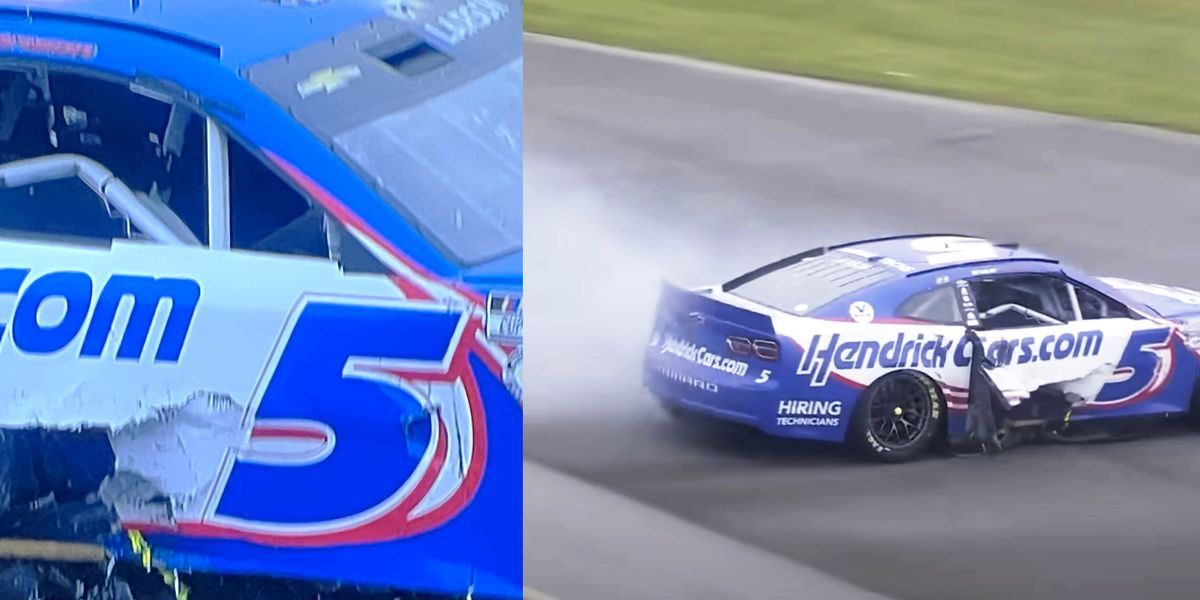NASCAR's Scariest Crash of the Year: What Went Wrong With Kyle Larson’s Door Bar Failure
The cabin of a race car can often appear impenetrable, so it can be jarring to see tubing inside of a car move around as we saw in the No. 5 Camaro of Kyle Larson in the NASCAR Cup race at Talladega on Sunday.
This content is imported from YouTube. You may be able to find the same content in another format, or you may be able to find more information, at their web site.
Larson was involved in a crash during an overtime restart that sent him down the banking and then bounced him right back up which caused him to be hit on the passenger side of his car by Ryan Preece in the No. 41 Mustang. In the aftermath of the incident, a door bar from the passenger side of Larson’s Camaro had become detached and intruded into the cabin. The crash also left evidence on the composite door panel of where the impact had occurred. The in-car view of Preece’s Mustang shows Larson’s Camaro sliding back up the banking while being inclined on the passenger side, which results in the front end of Preece’s car hitting the passenger side of Larson’s car at angle and the pressure from the hit immediately ejecting the passenger side window.
NASCAR
Once the cars came to a rest, we could see that one of the door bars on Larson’s Camaro had detached from the rest of the structure on the passenger side of that car and intruded into the cabin. Based on the handful of angles shown of the car, this appears to be a middle door bar that is located one slot down from the window opening in the illustration above.
NASCAR
There are likely a variety of factors that played into this bar getting detached. The first element is the angle of impact which resulted in the front of Preece’s car hitting the side of Larson’s car while it was partially up in the air, running into the bottom of those door bars instead of head-on. This appears to have resulted in the door bars and jack post being pushed up and one of the door bars appearing to detach from the rear vertical support. The likely point of detachment is circled in the illustration above.
NASCAR
One of the first things that’s noticeable about that specific door bar is that it does not have a triangular gusset like the bars above and below it, which is likely what resulted in it being easier to detach than the others which likely only got bent. The choice of where to place gussets is likely done based on a simulation on how the whole door bar structure is intended to work and the choice was seemingly made to allow it to deform and dissipate energy based on the most common types of crashes that NASCAR was able to simulate.
The extenuating circumstance in this case is likely the angle of impact being underneath those passenger door bars, which resulted in them being pushed up instead towards the cabin by the front end of Preece’s car. That front end consists of an aluminum bumper structure that can deform, but that is mounted to a fairly stiff front subframe assembly. On top of all of that, it appeared that Preece was trying to avoid Larson by getting on the accelerator but was unable to do so and instead ended up impacting him while throttled up.
NASCAR
In addition to the broken bar that was visible through the window opening, much of the other tubing on the passenger side appears to have bent. Those bars are likely designed to deform to an extent, but in this case, the impact appears to have been enough to move the in-car camera and possible even bend the shift linkage; after the crash, it sounded like Larson was unable to get the car back into gear.
NASCAR
Seeing something like a door bar tube detached is obviously worrying, and many immediately considered what would happen if the same type of impact happened on the driver’s side. While the passenger side of the NASCAR Next Gen center section is devised of tubing covered with a thin metal panel used as a barrier to the outside, the driver’s side is built to be much stiffer and stronger. If a similar impact happened on the driver’s side it would likely play out differently than what we saw for the impact on the passenger side here.
The driver’s side is constructed of steel tubing that is reinforced on both sides and on top with thick metal plates. In addition to that, the seat in the Next Gen car is closer to the middle of the car than in previous iterations of the NASCAR chassis in order to protect the driver better from left-side impacts. The entire Next Gen chassis was developed by NASCAR with Dallara and every single one is built by single source supplier Technique Chassis. Once each chassis is constructed or refurbished, it is sent to NASCAR to be inspected and certified before being released to teams to construct the car.
NASCAR follows these incidents very closely and immediately took Larson’s car back to their R&D center in Concord, North Carolina, in order to investigate and see if they can reconstruct the incident. From there, NASCAR will come up with any possible chassis updates or determine if there was some type of issue at the supplier during the construction of this center section.
With all of that said, this incident needs to be investigated carefully to see if it can be prevented in the future. There shouldn’t be anything intruding into the cabin, no matter what side the impact is happening from.
Source: Road & Track


